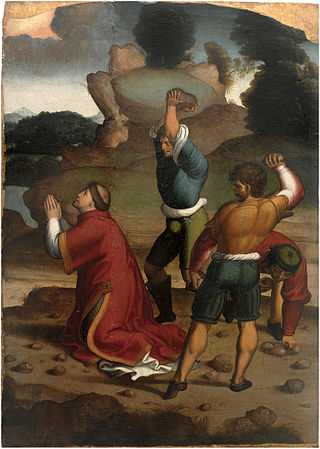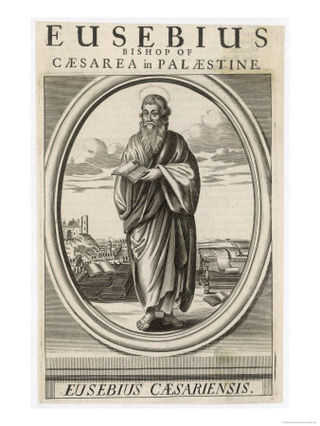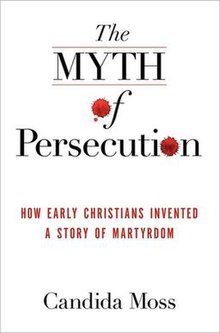
Polycarp was a Christian bishop of Smyrna. According to the Martyrdom of Polycarp, he died a martyr, bound and burned at the stake, then stabbed when the fire failed to consume his body. Polycarp is regarded as a saint and Church Father in the Catholic, Eastern Orthodox, Oriental Orthodox, Anglican, and Lutheran churches.

John the Apostle or Saint John the Beloved was one of the Twelve Apostles of Jesus according to the New Testament. Generally listed as the youngest apostle, he was the son of Zebedee and Salome. His brother James was another of the Twelve Apostles. The Church Fathers identify him as John the Evangelist, John of Patmos, John the Elder, and the Beloved Disciple, and testify that he outlived the remaining apostles and was the only one to die of natural causes, although modern scholars are divided on the veracity of these claims.

The Passion of Saints Perpetua and Felicity is a diary by Vibia Perpetua describing her imprisonment as a Christian in 203, completed after her death by a redactor. It is one of the oldest and most notable early Christian texts.
The Apostolic Fathers, also known as the Ante-Nicene Fathers, were core Christian theologians among the Church Fathers who lived in the 1st and 2nd centuries AD who are believed to have personally known some of the Twelve Apostles or to have been significantly influenced by them. Their writings, though widely circulated in early Christianity, were not included in the canon of the New Testament. Many of the writings derive from the same time period and geographical location as other works of early Christian literature which came to be part of the New Testament.

In Christianity, a martyr is a person who was or is killed for their testimony for Jesus or faith in Jesus. In years of the early church, stories depict this often occurring through death by sawing, stoning, crucifixion, burning at the stake, or other forms of torture and capital punishment. The word martyr comes from the Koine word μάρτυς, mártys, which means "witness" or "testimony".
The Scillitan Martyrs were a company of twelve North African Christians who were executed for their beliefs on 17 July 180 AD. The martyrs take their name from Scilla, a town in Numidia. The Acts of the Scillitan Martyrs are considered to be the earliest documents of the church of Africa and also the earliest specimen of Christian Latin.
Martyrdom of Polycarp is a manuscript written in the form of a letter that relates the religious martyrdom of Polycarp, Bishop of Smyrna and disciple of John the Apostle in the 2nd century AD. It forms the earliest account of Christian martyrdom outside of the New Testament. The author of Martyrdom of Polycarp is unknown, but it has been attributed to members of the group of early Christian theologians known as the Church Fathers. The letter, sent from the church in Smyrna to another church in Asia Minor at Philomelium, is partly written from the point of view of an eye-witness, recounting the arrest of the elderly Polycarp, the Romans' attempt to execute him by fire, and subsequent miraculous events.

The Diocletianic or Great Persecution was the last and most severe persecution of Christians in the Roman Empire. In 303, the emperors Diocletian, Maximian, Galerius, and Constantius issued a series of edicts rescinding Christians' legal rights and demanding that they comply with traditional religious practices. Later edicts targeted the clergy and demanded universal sacrifice, ordering all inhabitants to sacrifice to the gods. The persecution varied in intensity across the empire—weakest in Gaul and Britain, where only the first edict was applied, and strongest in the Eastern provinces. Persecutory laws were nullified by different emperors at different times, but Constantine and Licinius' Edict of Milan in 313 has traditionally marked the end of the persecution.

Saint Blandina was a Christian martyr who died in Lugdunum during the reign of Emperor Marcus Aurelius.

The persecution in Lyon in AD 177 was an outbreak of persecution of Christians in Lugdunum, Roman Gaul, during the reign of Marcus Aurelius, recorded in a contemporary letter preserved in Eusebius's Ecclesiastical History, book 5, chapter 1, which was written 150 years later in Palestine. Gregory of Tours also describes the persecution in the 6th century in De Gloria martyrum.

Christians were persecuted, sporadically and usually locally, throughout the Roman Empire, beginning in the 1st century AD and ending in the 4th century. Originally a polytheistic empire in the traditions of Roman paganism and the Hellenistic religion, as Christianity spread through the empire, it came into ideological conflict with the imperial cult of ancient Rome. Pagan practices such as making sacrifices to the deified emperors or other gods were abhorrent to Christians as their beliefs prohibited idolatry. The state and other members of civic society punished Christians for treason, various rumored crimes, illegal assembly, and for introducing an alien cult that led to Roman apostasy. The first, localized Neronian persecution occurred under Emperor Nero in Rome. A more general persecution occurred during the reign of Marcus Aurelius. After a lull, persecution resumed under Emperors Decius and Trebonianus Gallus. The Decian persecution was particularly extensive. The persecution of Emperor Valerian ceased with his notable capture by the Sasanian Empire's Shapur I at the Battle of Edessa during the Roman–Persian Wars. His successor, Gallienus, halted the persecutions.

Procopius of Scythopolis was a 4th century martyr who is venerated as a saint. He was a reader and exorcist in the church at Scythopolis; he also was famous as an ascetic and erudite theologian. Eusebius of Caesarea wrote of his martyrdom, which occurred during the persecution of Roman Emperor Diocletian, and stated that "he was born at Jerusalem, but had gone to live in Scythopolis, where he held three ecclesiastical offices. He was reader and interpreter in the Syriac language, and cured those possessed of evil spirits." Eusebius wrote that Procopius was sent with his companions from Scythopolis to Caesarea Maritima, where he was decapitated.

Christianity in the ante-Nicene period was the time in Christian history up to the First Council of Nicaea. This article covers the period following the Apostolic Age of the first century, c. 100 AD, to Nicaea in 325 AD.
Saint Domnina and her daughters Berenice and Prosdoce are venerated as Christian martyrs by the Roman Catholic and Eastern Orthodox Churches. St. Domnina is not to be confused with Domnina of Syria, a 5th century figure.

Pliny the Younger, the Roman governor of Bithynia and Pontus, wrote a letter to Emperor Trajan around AD 112 and asked for counsel on dealing with the early Christian community. The letter details an account of how Pliny conducted trials of suspected Christians who appeared before him as a result of anonymous accusations and asks for the Emperor's guidance on how they should be treated.

Candida R. Moss is an English public intellectual, journalist, New Testament scholar and historian of Christianity, and as of 2017, the Edward Cadbury Professor of Theology in the Department of Theology and Religion at the University of Birmingham. A graduate of Oxford and Yale universities, Moss specialises in the study of the New Testament, with a focus on the subject of martyrdom in early Christianity, as well as other topics from the New Testament and early Church History. She is the winner of a number of awards relating to her research and writing.

On the Martyrs of Palestine is a work by church historian and Bishop of Caesarea, Eusebius, relating the persecution of Christians in Caesarea under Roman Emperor Diocletian. The work survives in two forms, a shorter recension which formed part of his Ecclesiastical History, and a longer version, discovered only in 1866. Eusebius was present in Caesarea at the time of the persecutions he recounts.
The Acts of Carpus, Papylus, and Agathonice is a martyrdom account about three Christians traveling through Pergamum until they are discovered by the pagan authority of the city and put to death by them. The date of the text is disputed amongst biblical scholars. Either from the second century AD of Marcus Aurelius's reign or the third century AD of Decius's reign.
The Martyrdom of Pionius is an account dating from about 250 AD to 300 AD of the martyrdom of a Christian from Smyrna named Pionius. It is also known as The Martyrdom of Pionius the Presbyter and His Companions, The Acts of Pionius, and in Latin as Martyrium Pionii or Passio Pionii. Pionius was a presbyter, and was most likely killed between 249 and 251 AD during the rule of the Roman Emperor Decius. The feast day of Saint Pionius is kept on March 11 in Eastern Orthodox churches, and on February 1 in Roman Catholicism.
Christian persecution complex is the belief, attitude, or world view that Christian values and Christians are being oppressed by social groups and governments in the Western world. This belief is promoted by certain American Protestant churches, and some Christian- or Bible-based groups in Europe. It has been called the "Evangelical", "American Christian" or "Christian right" persecution complex.













